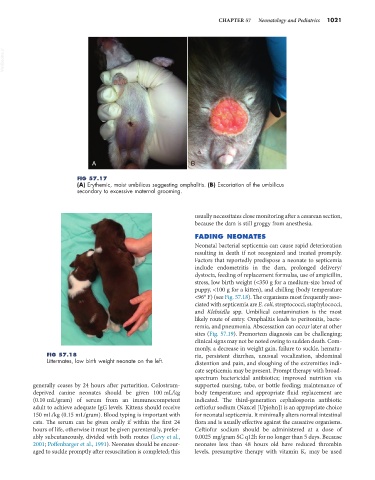Page 1049 - Small Animal Internal Medicine, 6th Edition
P. 1049
CHAPTER 57 Neonatology and Pediatrics 1021
VetBooks.ir
A B
FIG 57.17
(A) Erythemic, moist umbilicus suggesting omphalitis. (B) Excoriation of the umbilicus
secondary to excessive maternal grooming.
usually necessitates close monitoring after a cesarean section,
because the dam is still groggy from anesthesia.
FADING NEONATES
Neonatal bacterial septicemia can cause rapid deterioration
resulting in death if not recognized and treated promptly.
Factors that reportedly predispose a neonate to septicemia
include endometritis in the dam, prolonged delivery/
dystocia, feeding of replacement formulas, use of ampicillin,
stress, low birth weight (<350 g for a medium-size breed of
puppy, <100 g for a kitten), and chilling (body temperature
<96° F) (see Fig. 57.18). The organisms most frequently asso-
ciated with septicemia are E. coli, streptococci, staphylococci,
and Klebsiella spp. Umbilical contamination is the most
likely route of entry. Omphalitis leads to peritonitis, bacte-
remia, and pneumonia. Abscessation can occur later at other
sites (Fig. 57.19). Premortem diagnosis can be challenging;
clinical signs may not be noted owing to sudden death. Com-
monly, a decrease in weight gain, failure to suckle, hematu-
FIG 57.18 ria, persistent diarrhea, unusual vocalization, abdominal
Littermates, low birth weight neonate on the left. distention and pain, and sloughing of the extremities indi-
cate septicemia may be present. Prompt therapy with broad-
spectrum bactericidal antibiotics; improved nutrition via
generally ceases by 24 hours after parturition. Colostrum- supported nursing, tube, or bottle feeding; maintenance of
deprived canine neonates should be given 100 mL/kg body temperature; and appropriate fluid replacement are
(0.10 mL/gram) of serum from an immunocompetent indicated. The third-generation cephalosporin antibiotic
adult to achieve adequate IgG levels. Kittens should receive ceftiofur sodium (Naxcel [Upjohn]) is an appropriate choice
150 mL/kg (0.15 mL/gram). Blood typing is important with for neonatal septicemia. It minimally alters normal intestinal
cats. The serum can be given orally if within the first 24 flora and is usually effective against the causative organisms.
hours of life, otherwise it must be given parenterally, prefer- Ceftiofur sodium should be administered at a dose of
ably subcutaneously, divided with both routes (Levy et al., 0.0025 mg/gram SC q12h for no longer than 5 days. Because
2001; Poffenbarger et al., 1991). Neonates should be encour- neonates less than 48 hours old have reduced thrombin
aged to suckle promptly after resuscitation is completed; this levels, presumptive therapy with vitamin K 1 may be used

